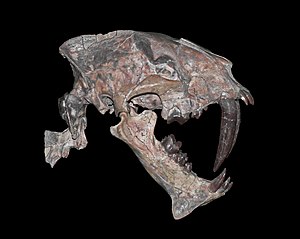Nimravidae
aus Wikipedia, der freien Enzyklopädie
| Nimravidae | ||||||||||||
|---|---|---|---|---|---|---|---|---|---|---|---|---|

Hoplophoneus primaevus im Staatlichen Museum für Naturkunde Karlsruhe. | ||||||||||||
| Zeitliches Auftreten | ||||||||||||
| Eozän bis Pliozän | ||||||||||||
| 42 bis 7,25 Mio. Jahre | ||||||||||||
| Fundorte | ||||||||||||
| Systematik | ||||||||||||
| ||||||||||||
| Wissenschaftlicher Name | ||||||||||||
| Nimravidae | ||||||||||||
| Cope, 1880 | ||||||||||||
Die Familie der Nimravidae ist eine ausgestorbene Linie der katzenartigen Raubtiere. Sie entstanden im Eozän vor etwa 50 Millionen Jahren. Ursprünglich wurden sie für Vorfahren der Katzen (Felidae) gehalten, doch heute gelten sie als deren Schwestergruppe. Demnach entwickelten sie ihre katzenartigen Merkmale durch konvergente Evolution. Weil einige Arten der Nimraviden mächtige Säbelzähne besaßen, die an jene der Säbelzahnkatzen (Machairodontinae) erinnern, aber die Nimravidae eine eigene Familie bilden, bezeichnet man sie auch als Scheinsäbelzahnkatzen. Die Barbourofelidae wurden ursprünglich als Unterfamilie der Nimraviden betrachtet, gelten heute aber als eigenständige Familie.
Bekannte Gattungen der Nimravidae:
- Dinaelurus Eaton 1922
- Dinailurictis
- Dinictis Leidy 1854
- Eusmilus Gervais 1876
- Hoplophoneus Cope 1874
- Eofelis Kretzoi 1938
- Maofelis Averianov et al. 2016[1]
- Nanosmilus Cope 1880
- Nimravus Cope 1879
- Pangurban Proust, Barrett & Tomiya, 2022[2]
- Pogonodon Cope 1880
- Quercylurus Ginsburg 1979


Literatur
[Bearbeiten | Quelltext bearbeiten]- Alan Turner: The big cats and their fossil relatives. Columbia University Press, New York NY 1997, ISBN 0-231-10229-1.
Einzelnachweise
[Bearbeiten | Quelltext bearbeiten]- ↑ Alexander Averianov, Ekaterina Obraztsova, Igor Danilov, Pavel Skutschas und Jianhua Jin: First nimravid skull from Asia. Scientific Reports 6, 2016, S. 25812, doi:10.1038/srep25812
- ↑ Ashley W. Poust, Paul Z. Barrett und Susumu Tomiya: An early nimravid from California and the rise of hypercarnivorous mammals after the middle Eocene climatic optimum. Biology Letters 18, 2022, S. 20220291, doi:10.1098/rsbl.2022.0291
Weblinks
[Bearbeiten | Quelltext bearbeiten]Text is available under the CC BY-SA 4.0 license; additional terms may apply.
Images, videos and audio are available under their respective licenses.
